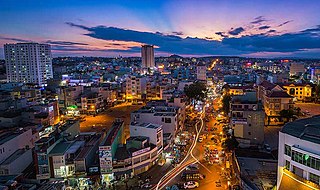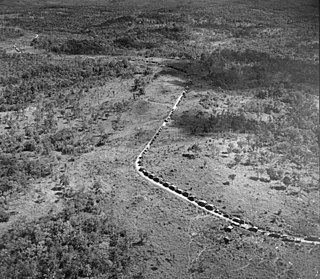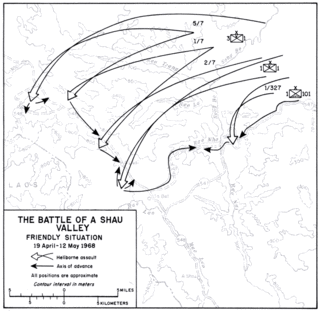
Major General Nguyễn Văn Hiếu was a general in the South Vietnamese Army of the Republic of Vietnam (ARVN). As a child he lived in Shanghai. He later emigrated with his ethnic Vietnamese parents to Saigon when the Chinese Communist Party took over China in 1949. He attended Aurore University in Shanghai, China. In 1950, he attended the Vietnamese Military Academy, graduating second in his class in 1951. In 1963, he graduated from Command and General Staff College, at Fort Leavenworth, Kansas.

Pleiku is a city in central Vietnam, located in the Central Highlands region. It is the capital of the Gia Lai Province. Many years ago, it was inhabited primarily by the Bahnar and Jarai ethnic groups, sometimes known as the Montagnards or Degar, although now it is inhabited primarily by the Kinh ethnic group. The city is the centre of the urban district of Pleiku which covers an area of 261 km².

The 1st Battalion, 227th Aviation Regiment is an attack helicopter battalion of the Combat Aviation Brigade, 1st Cavalry Division. The battalion is an AH-64 Apache battalion based at Fort Cavazos, Texas.

The Battle of Mang Yang Pass was one of the last battles of the First Indochina War which took place on 24 June 1954. The battle was one of the bloodiest defeats of the French Union forces, along with the battle of Dien Bien Phu shortly beforehand.

The Capital Mechanized Infantry Division, also known as Fierce Tiger Division, is currently one of the six mechanized infantry divisions in the Republic of Korea Army. It is part of the VII Maneuver Corps, tasked with covering approaches to Seoul from North Korea and counterattack operations.

The 17th Cavalry Regiment is a historical organization within the United States Army that began as a regiment of cavalry after the Pancho Villa Expedition. The unit was constituted on 1 July 1916 in the Regular Army as the 17th Cavalry at Fort Bliss, Texas and originally inactivated 26 September 1921 at the Presidio of Monterey, California. Formerly a part of the 1950s Combat Arms Regimental System, it was reorganized as a part of the U.S. Army Regimental System, an ongoing effort to maintain the lineage and history of the U.S. Army through its units. Today, the 17th Cavalry Regiment is found across the army within the combat aviation brigades, where the squadrons, now constituted as attack/recon helicopter squadrons, carry on the legacy of the 17th Cavalry Regiment.

The siege of Plei Me was the beginning phase of the first major confrontation between soldiers of the North Vietnamese People's Army of Vietnam (PAVN) and the U.S. Army during the Vietnam War. The lifting of the siege by South Vietnamese forces and American air power was followed by the pursuit of the retreating North Vietnamese from 28 October until 12 November, setting the stage for the Battle of Ia Drang.

Khe Sanh Combat Base was a United States Marine Corps outpost south of the Vietnamese Demilitarized Zone (DMZ) used during the Vietnam War.

An Khê is a town of Gia Lai province in the Central Highlands region of Vietnam.

Operation Delaware/Operation Lam Son 216 was a joint military operation launched during the Vietnam War. It began on 19 April 1968, with troops from the United States and the Army of the Republic of Vietnam (ARVN) moving into the A Sầu Valley. The A Sầu Valley was a vital corridor for moving military supplies coming from the Ho Chi Minh Trail and was used by the People's Army of Vietnam (PAVN) as a staging area for numerous attacks in northern I Corps. Other than small, special operations reconnaissance patrols, American and South Vietnamese forces had not been present in the region since the Battle of A Shau in March 1966, when a U.S. Special Forces camp located there was overrun.

The 23rd Division of the Army of the Republic of Vietnam (ARVN)—the army of the nation state of South Vietnam that existed from 1955 to 1975—was part of the II Corps that oversaw the Central Highlands.

The 22nd Division of the Army of the Republic of Vietnam (ARVN) was part of the II Corps that oversaw the region of the Central Highlands north of the capital Saigon. The 22nd Division was based in Ba Gi near the south central coast.

The 69th Armor is an armored (tank) regiment of the United States Army. The 69th Armor Regiment is part of the U.S. Army Regimental System with only two battalions, the 2nd and 3rd Battalion, 69th Armor Regiment, existing in separate brigades and representing the regiment as a whole. 2–69 AR is currently stationed at Fort Stewart, Georgia as part of the 2nd Armor Brigade Combat Team ("Spartans"), 3rd Infantry Division and 3–69 AR is stationed at Fort Stewart, Georgia as part of the 1st Armor Brigade Combat Team ("Raider"), 3rd Infantry Division. Both battalions have transformed from tank pure battalions into combined arms battalions (CAB), Each comprising two tank companies and one mechanized infantry company as of August 2019.

The Battle of An Ninh took place from 18–19 September 1965 between elements of the Vietcong (VC) 94th and 95th Battalions, 2nd Regiment, 3rd Division and the U.S. 2nd Battalion, 502nd Infantry Regiment and Army of the Republic of Vietnam (ARVN) Rangers. It occurred during an operation codenamed Operation Gibraltar, developed by MACV to clear the area around the 1st Cavalry Division's base at An Khê, South Vietnam.

Camp Radcliff is a former United States Army base in the An Khê District in central Vietnam.

National Route 19 runs across Vietnam roughly in line with the 14th parallel north. The route includes two segments: National Route 19 begins at Qui Nhơn and ends just short of the Vietnam-Cambodia border, while National Route 19B begins on the Qui Nhơn peninsula and joins Route 1 east of Phu Cat Airport.

Operation Crazy Horse, named after Lakota warrior Crazy Horse, was a search and destroy mission during the Vietnam War conducted by military forces of the United States, South Vietnam, and the Republic of South Korea in two valleys in Bình Định Province of South Vietnam.
Operation Austin IV was a search and destroy operation conducted by the 1st Brigade, 101st Airborne Division and the 173rd Airborne Brigade in western Quang Duc and Phước Long Provinces, from 1 to 18 May 1966.
Operation Shenandoah II was a security operation conducted during the Vietnam War by the U.S. 1st Infantry Division to secure and repair Highway 13, South Vietnam from 29 September to 19 November 1967.
Operation Walker was a security operation conducted during the Vietnam War by the U.S. Army’s 1st Battalion, 503rd Infantry Regiment, 173rd Airborne Brigade in Bình Định Province, South Vietnam from 17 March 1968 to 31 January 1969.



















